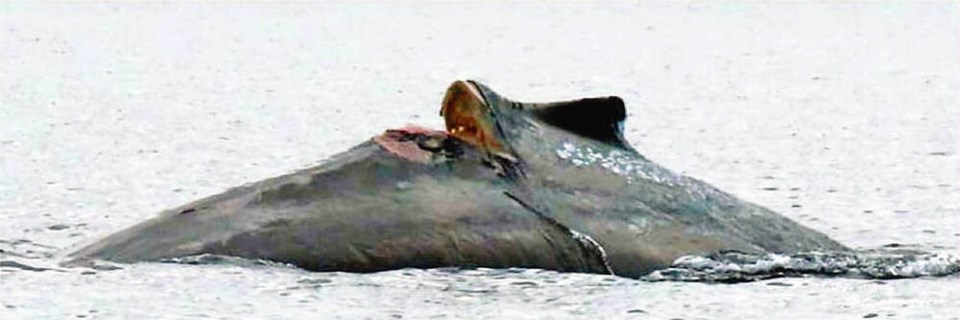A humpback whale calf that suffered a severe gash across its back last year from a boat propeller appears to be healing and surviving in the Salish Sea.
Peter Hamilton of Comox photographed the one-year-old calf in September near Texada Island not long after it suffered the massive wound.
Hamilton said Thursday he was heartened and surprised when the calf he nicknamed Hope was spotted in late January with her mother, Stingray. But he said her injury should be a warning for boaters to follow distancing rules.
“It was an extremely severe wound. There was lots of blood and I could actually see the spinal cord,” said Hamilton, founding director of Lifeforce Ocean Friends, a whale-protection advocacy group based in the Comox Valley. “The mom, Stingray, stayed close to her calf. The injury appeared to impede the calf’s natural behaviours such as fluking. I thought it could have been fatal.”
Hope was spotted swimming with Stingray, on Dec. 14 near Denman Island and, most recently, on Jan. 24 near Campbell River. The wound, which split the young whale’s back, seemed to be healing.
The Marine Research and Education Society, based in Port McNeill, identifies and documents humpbacks in the Salish Sea and asked Hamilton to give the numbered calf a nickname.
“I thought Hope sends a message of hope for recovery from the injuries and hopefully peace for all humpbacks,” said Hamilton.
Based on the recent sightings, Hope appears to be doing well, the society said in a Facebook post.
“Hope is alive … we did not realize just how inspirational this humpback calf’s nickname would prove to be,” it said. “Fortuitously, the propeller did not severe Hope’s spinal cord nor did Hope die from infection.”
Researchers said there are other humpbacks that show no external injuries but die due to blunt force from collisions with boats that cause massive internal injuries. Others get caught up in grab traps and floats, become exhausted from pulling the weight and drown.
“Too many whales who have suffered collisions or entanglements are undetected or unreported … dead whales often sink to the bottom of the ocean, their realities unknown,” the society said.
Humpbacks usually depart for warm-water breeding grounds in Hawaii, Mexico and Central America during the winter months, but it isn’t known if Stingray and Hope will make the journey. Mothers usually wean their calves after about a year, said Hamilton.
The Marine Research and Education Society said humpback whales have staggered departure and return times between the feeding areas around the Island and breeding grounds. “While some humpbacks may indeed not migrate from the feeding grounds off B.C., we have yet to prove that,” the group said. “We would have to document the same whale off our coast in every month to prove they did not migrate.”
The organization said it posted a graphic image of Hope’s injury to raise awareness of damage caused by boat strikes and boaters’ behaviour.
“We are humpback whale researchers and know all too well just how unpredictable humpbacks can be, and how much high-risk boater behaviour there is,” said the society.
All boaters are required to stay 400 metres from endangered southern resident killer whales from Campbell River to just north of Ucluelet. Federal regulations also require them to maintain a 200-metre distance from transient, or Bigg’s orcas, and whales with calves, and 100 metres from all other whales, dolphins and porpoises.
Hamilton said boaters often don’t follow those rules. Even as he was photographing Hope with a telephoto lens at the required distance, a large boat sped by for a closer look at the calf.
To report an incident, call the DFO reporting line at 1-800-465-4336, or go to the Marine Research and Education Society website.



